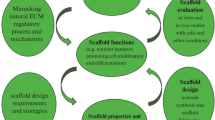Abstract
Three-dimensional scaffolds play an important role in tissue engineering as an adhesive substrate for implanted cells and a physical support to guide the formation of new organs. The scaffolds should facilitate cell adhesion, promote cell growth, allow the retention of differentiated cell functions, and be biocompatible, biodegradable, highly porous with a large surface-to-volume ratio, mechanically strong, and malleable. A number of biodegradable three-dimensional scaffolds have been developed for tissue engineering. This paper reviews some of the recent events in the development of these scaffolds.
Similar content being viewed by others
Author information
Authors and Affiliations
Additional information
Received: March 6, 2002
Rights and permissions
About this article
Cite this article
Tateishi, T., Chen, G. & Ushida, T. Biodegradable porous scaffolds for tissue engineering. J Artif Organs 5, 77–83 (2002). https://doi.org/10.1007/s100470200014
Issue Date:
DOI: https://doi.org/10.1007/s100470200014




